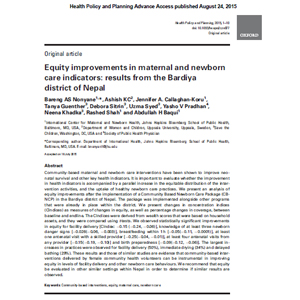
Community-based maternal and newborn care interventions have been shown to improve neonatal survival and other key health indicators. It is important to evaluate whether the improvement in health indicators is accompanied by a parallel increase in the equitable distribution of the intervention activities, and the uptake of healthy newborn care practices. We present an analysis of equity improvements after the implementation of a Community Based Newborn Care Package (CBNCP) in the Bardiya district of Nepal. The package was implemented alongside other programs that were already in place within the district. We present changes in concentration indices (CIndices) as measures of changes in equity, as well as percentage changes in coverage, between baseline and endline. The CIndices were derived from wealth scores that were based on household assets, and they were compared using t-tests. We observed statistically significant improvements in equity for facility delivery [CIndex: 0.15 ( 0.24, 0.06)], knowledge of at least three newborn danger signs [ 0.026( 0.06, 0.003)], breastfeeding within 1 h [ 0.05( 0.11, 0.0001)], at least one antenatal visit with a skilled provider [ 0.25( 0.04, 0.01)], at least four antenatal visits from any provider [ 0.15( 0.19, 0.10)] and birth preparedness [ 0.09( 0.12, 0.06)]. The largest increases in practices were observed for facility delivery (50%), immediate drying (34%) and delayed bathing (29%). These results and those of similar studies are evidence that community-based interventions delivered by female community health volunteers can be instrumental in improving equity in levels of facility delivery and other newborn care behaviours. We recommend that equity be evaluated in other similar settings within Nepal in order to determine if similar results are observed.